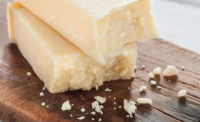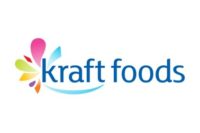Cheesemakers go for the bold
Natural cheese production continues to trend up. Bold flavors and artisan cheeses draw consumers, and processors look to grow sales with portability and snacking options.











As interesting flavor options, artisan cheeses, portion-control and portability continue to trend up for cheese, so does natural cheese production.
Based on data collected from SymphonyIRI Group, Chicago, the natural cheese segment saw a 6.5% increase in dollar sales for the 52 weeks ended August 12, 2012 (see table). The biggest increase to the category came from refrigerated grated cheese, with sales up 17.5% and units up 14.7%. Alongside that, natural slices were up 8.3% in sales and 7.4% in units, natural shredded was up 8.7% in sales, with units up 1.5%, and natural crumbled saw an 8.3% increase in sales and units were up 4.8%. Keeping in tune with the trend towards portability, natural string cheese also saw a sales increase of 8.1% and units were up 0.6%.
The draw for convenience and on-the-go items continues, with even more natural offerings and/or revamped formulas from processors. Consumers want easy, but they’re focusing more on health and wellness as well, cheesemakers said.
Processed cheese, however, isn’t seeing the same success. This category saw a small 1.5% increase in dollar sales for the 52 weeks ended August 12, 2012, but units dropped 4.8% (see table). In the imitation cheese segment, sales dropped 3.4% and units were down 15%.
It’s the natural way
This year Organic Valley, La Farge, Wis., launched unprocessed, 100% real American cheese singles for consumers looking for convenience and nutrition, according to Stacy Fahey, public affairs assistant for Organic Valley. When it comes to organic cheese, “we are seeing an increased demand for convenience and snack cheese,” she said.
Sargento, Plymouth, Wis., answered the call for natural, portion-control and new flavors with its line of Natural Blends. The blends are available in sliced natural cheeses and natural snack cheeses. Sargento combines two cheeses for a new taste, such as Colby Pepper Jack and Cheddar Mozzarella. The company also introduced a line of Ultra Thin Sliced Natural Cheeses. Three slices of Ultra Thin weighs just more than 1 ounce. Consumers like having the choice of using one slice for some family members and two or three for others, but all from the same package, said Barbara Gannon, vice president corporate communications and government relations for Sargento. Plus, there’s the added benefit of the thinner slices having less fat and sodium than the average 1 ounce slice.
Sargento also relaunched many of its shredded cheeses. “We learned that consumers like to purchase the convenience of shredded cheese but want it to look like it was shredded by hand in their kitchen,” said Gannon. “Traditional Cut and Fine Cut offers that. We also introduced Chef Blends, a combination of multiple cheese varieties in one package, to help satisfy their culinary flair.” Flavors in this new line include Four Cheese Pizzeria and Four State Cheddar.
Tillamook County Creamery Association, Tillamook, Ore., also sees the trend toward healthier, unprocessed options in the cheese category, according to Jay Allison, vice president of sales and marketing. For Tillamook, its cheese is made with milk from cows not treated with artificial growth hormones. All its Cheddars are aged naturally. The company’s focus is making sure its customers know that.
“In 2012 we developed an infographic aimed at creating awareness for our consumers while educating them on the difference between natural versus processed cheese,” said Allison. This application is promoted on its website, Facebook and Twitter pages.
What’s on the menu? Bold and interesting flavors
Plymouth, Wis.-based Sartori Co.recognizes the draw for more specialty cheeses. As the marketplace has globalized and people have become more educated about what they eat, there’s been an increase for more unique and specialized products, said Chad Vincent, chief marketing officer for Sartori.
“We see the consumer still willing to purchase high-end artisan cheese — it is a small indulgence and affordable luxury,” said Vincent. “Smaller sizes and price points are helping consumers feel more comfortable trying new items. There continues to be an upswing in ‘in-home entertainment,’ and we see smaller portions in the deli case enabling people to purchase/sample a variety of unique and different [cheeses] for their parties and events.”
Foodservice is another target. “In upscale restaurants there is a growing trend for specialty cheese courses. These courses can include an array of unique cheese products with appropriate pairings,” he said.
To address this trend, Sartori added three new limited-edition items to its line this fall — Extra-Aged Goat, which has won multiple awards, including a Gold Medal at the Global Cheese Awards in the United Kingdom; the Cannella BellaVitano, a sweet, buttery cheese that’s steeped in cinnamon liqueur and aged at least 15 months; and Peppermint BellaVitano, which is hand-coated with crushed peppermint candy, it melts and turns the cheese pink. (This cheese was created in support of National Breast Cancer Month.)
Cabot CreameryCooperative, Montpelier, Vt., (a unit of Agri-Mark)
continues to see a strong interest in sharp and bold flavor profiles, which has pushed the success of its Seriously Sharp Cheddar, its No. 1 product nationwide. Also, its introduction of the new Aged Reserve product is another indication of the interest in strong flavor profiles. “In our product mix we are seeing that the sharper aged profiles and items with more bite — from peppers or other flavors — are performing very well,” said Amy Levine, marketing director for Cabot.
Grafton Village Cheese, Grafton, Vt., notes that specialty cheese is a rapidly growing segment, with more consumers appreciating fine cheeses. These consumers are knowledgeable about cheese types, milk sources and production methods, and they want to be sure that their cheeses are made with local, quality ingredients, said Meri Spicer, sales director for Grafton Village Cheese.
To further tap into this market, Grafton introduced a line of cave-aged cheeses, some with cow’s milk, some with sheep’s milk, and some with a mix of both. “It’s the first time in our history that we’ve produced cheeses other than Cheddar,” said Spicer. The company also updated its packaging to emphasize that it makes raw milk cheese in Vermont. Once again, the marketing of natural, locally made product continues to grab consumers.
Size matters
Knowing what the consumer wants is key for Vermont Farmstead Cheese Co. The South Woodstock, Vt., processor sees packaging, portion sizes and price points run the spectrum — from small, individually wrapped products (targeting young families), to large blocks of cheese (for a crowd). “Consumers are interested in buying the ‘right sizes’ and will pay for convenience and quality,” said Sharon Huntley, marketing director for Vermont Farmstead Cheese.
To address consumers’ demand for these so-called right sizes, Vermont Farmstead opened its new cut-and-wrap facility in Windsor, Vt., in October. The facility will also be available to other Vermont and New England cheesemakers who may be looking for their own solution to packaging their products.
Vermont Farmstead added interesting new flavors and formed a new partnership this year as well. Tapping right into the desire for bold flavors is its line of flavored WindsorDales (a raw, British-style hard cheese) that includes cranberry, blueberry, chocolate stout and cracked pepper flavors. The cheesemaker also partnered with Gillingham & Son’s General Store to create a new line of cheeses called Vermont Heritage.
Weight Watchers Cheese, manufactured by Schreiber Foods, Green Bay, Wis., believes snacking continues to be a mega trend. In terms of portion sizes, consumers are looking for easy, on-the-go cheese snacks, said Lana Dose, brand manager at Schreiber. Consumers are looking to customize their cheese portions, buying only enough cheese for one or two people. The brand answered the call for portion-controlled options with the launch of new deli items — reduced-fat American, Pepper Jack and Swiss cheese slices — in the Northeast. To keep up with the bold flavor trend, the company added a new Jalapeno string cheese flavor in September.
When it comes to portability and convenience, Bel Brands USA, a Chicago-based subsidiary of Fromageries Bel in France, has seen significant growth from the trend. Thanks to its success with The Laughing Cow Cheese wedges, Babybel cheeses and its newest addition of Laughing Cow Cream Cheese Spreads, it’s become America’s No. 1 branded snacking cheese.
The company’s success goes beyond the convenience aspect; it comes back to the desire for interesting flavors, according to Ann Legan, vice president for marketing at Bel. It’s the fusion of health benefits, accessibility and indulgence, she said. The draw comes from making exotic, gourmet and globally inspired flavors accessible. (Read more about Bel Brands in the October Dairy Foods. Also, check out the newest flavor addition to its Babybel line on page 19 in this issue.)
Cheesemakers Are Talking About:
• Natural and local ingredients
• Bold and exotic flavors
• Portion-control
• Artisan-style cheeses
• Convenience and portability
In restaurants, Cheddar is the most popular flavor
By Mary Chapman, Technomic Inc.
A search of Technomic’s MenuMonitor online trend-tracking resource, which analyzes the menus of more than 1,200 top chains, emerging concepts and leading independent restaurants, finds cheese is found in every meal part, from adult beverages to desserts. There are 23,227 items in the second quarter of 2012, a number that is up almost 5% from 22,197 in the same period of 2011.
Technomic research also finds:
•The top five cheeses named in the menu descriptions of entrées featuring cheese (of which there are 15,515) are Cheddar (named in the menu descriptions of 18%), mozzarella (13%), Parmesan (11%), Provolone (8%) and blue cheese (6%).
•The most popular cheeses on sandwiches are, in order: provolone, Cheddar, Swiss, mozzarella and Parmesan.
•The leading cheeses on burgers: Cheddar, American, Swiss, Pepper Jack and blue cheese.
•The number of side dishes with cheese is up 14%, to 887 from 779. Atlanta Bread Company added Asiago loaves and breadsticks; Denny’s added Cheddar Cheese Hash Browns and Smoked Cheddar Mashed Potatoes; and Fulton’s Crab House added 7 Cheese Macaroni.
•Artisan is found as a descriptor a few items across menus, but beyond the cheese plates offered at upscale casual and fine dining restaurants, it more often describes the bread (in sandwiches) or crust (in pizza).
— Mary Chapman is the director of product innovation
at Technomic Inc., Chicago.
Natural cheese, artisan cheese grow at retail and in foodservice
By Cara Kelly, Innovation Center for U.S. Dairy
Realizing their commitment to growing the dairy industry, U.S. dairy farmers funded research to drill into market opportunities for cheese. The findings indicate natural cheese takes center stage in terms of product growth, with peaks at retail and in foodservice.
According to SymphonyIRI group, Chicago, this category segment makes up the lion’s share of volume at retail, with slight gains annually since 2009. In fact, natural cheese withstood price increases to grow slightly in the last two years, while processed cheese sales dropped. Additionally, according to the NPD Group, the percentage of U.S. individuals who claim to have consumed natural cheese during a two-week period rose to 59% in 2011, a 10-year high.
The growth in specialty cheeses contributes to this trend. Today, the United States produces more than 1 billion pounds of specialty cheese annually, and checkoff-supported technical training and short courses continue to promote growth in this category.
Retail sales data indicates growth opportunities lie with flavors beyond Cheddar and mozzarella. Today, through Dairy Research Institute research and technology advancements, new lines and line extensions are possible. These include value-added options such as higher protein, lower sodium, probiotics and other ingredients.
Beyond retail, foodservice is a definite high point in terms of growth, with a 45% increase in chain restaurant menu mentions, according to Technomic, Chicago. Today, the number of menu items including the name of a specific natural cheese has grown more than 40% since 2007 and almost 30% in the last two years.
Natural cheese varieties commonly called out on menus include Cheddar, Swiss, Monterey Jack, Pepper Jack, blue cheese, Romano, Parmesan and mozzarella. Plus, several quick-serve restaurants include attributes such as natural, real and fresh, plus information about the age of the cheese and its location of origin. Some menus also mention specific cheese brands.
One factor in the growth of natural cheese could be that this segment’s cleaner labels align with growing food trends. In addition, research shows that natural cheeses (like other cheese options) have nearly universal appeal, with nearly equal consumption across all adult age segments and genders.
More research is under way to determine the benefits consumers attribute to natural cheese and if they’re willing to pay a premium for it. But in the meantime, natural cheese continues to boom.
— Cara Kelly is the director of strategy, insights and planning at the Innovation Center for U.S. Dairy, Rosemont, Ill.
Looking for a reprint of this article?
From high-res PDFs to custom plaques, order your copy today!








